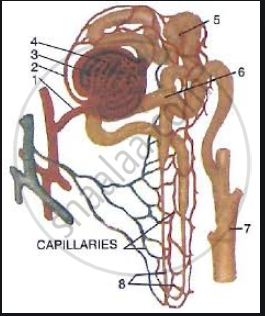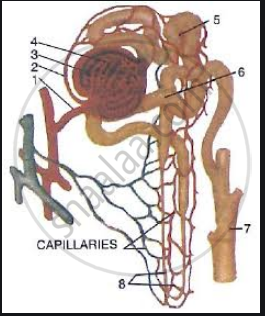Advertisements
Advertisements
प्रश्न
Why is it necessary to maintain a normal osmotic concentration of the blood?
उत्तर
Maintaining a normal osmotic concentration in the body means regulating the percentage of water and salts. If this regulation mechanism fails we either end up losing vital salts and water or may accumulate unwanted salts and excess water in our body.
APPEARS IN
संबंधित प्रश्न
The Biological/technical term for The removal of nitrogenous wastes from the body
What does the bladder in our body do?
Name the following:
The vein in which urea concentration is maximum
The following diagram represents a mammalian kidney tubule (nephron) and its blood supply.

Parts indicated by the guidelines 1to 8 are as follows:
1. Afferent arteriole from renal artery
2. Efferent arteriole
3. Bowman's capsule
4. Glomerulus
5. Proximal convoluted tubule with blood capillaries
6. Distal convoluted tubule with blood capillaries
7. Collecting tubule
8. U-shaped loop of Henle
Study the diagram and answer the question that follow:
Which structure contains the highest concentration of urea?
The following diagram represents a mammalian kidney tubule (nephron) and its blood supply.

Parts indicated by the guidelines 1to 8 are as follows:
1. Afferent arteriole from renal artery
2. Efferent arteriole
3. Bowman's capsule
4. Glomerulus
5. Proximal convoluted tubule with blood capillaries
6. Distal convoluted tubule with blood capillaries
7. Collecting tubule
8. U-shaped loop of Henle
Study the diagram and answer the question that follow:
Which structure (normally) contains the lowest concentration of glucose?
Choose the correct option.
Deproteinised plasma is not found in ______.
Answer the following question.
Why do we get bad breath after eating garlic or raw onion?
The mode of excretion of nitrogenous wastes like ammonia which takes place by simple diffusion is called ______.
What is the purpose of making urine in the human body?
Given below is a list of substances - select the ones that need to be eliminated from the body.
Glucose, excess water, amino acids, urea, carbon dioxide, excess common salt, glycogen, uric acid.
